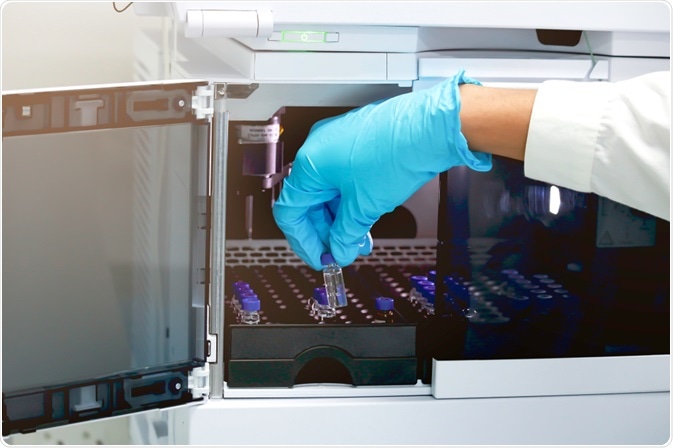Fast Protein Liquid Chromatography (FPLC) is a type of liquid chromatographic technique that is often used to analyze and purify protein mixtures.

Image Credit: Stella_E/Shutterstock.com
As with other chromatographic techniques, the separation of components is based on the different affinities for the mobile phase and the stationary phase. Typically, the mobile phase is an aqueous buffer solution, and the flow of the solution is controlled by a positive-displacement pump, which is kept constant.
In contrast, the stationary phase is typically a resin comprised of cross-linked agarose beads packed in a cylindrical glass or plastic column. The resin is available in a range of different bead sizes as well as surface ligands depending on the application.
FPLC has a broad range of applications due to the wide variety of resins and buffers. However, it is generally applied only to proteins. Furthermore, the buffer pressure used is relatively low, but the flow rate is relatively high, which contrasts with high-performance liquid chromatography (HPLC) methods.
When used for the analysis of mixtures, the eluant is collected in fractions, which can be further analyzed by other methods like mass spectrometry. However, when the application is for protein purification, there may be a collection for purified products and another for waste.
FPLC components
FPLC consist of one or two high-precision pumps, a control unit, a column, a detection system, and a fraction collector. Two pumps are generally used, one for each buffer that combines the output of both in a mixing chamber. The system allows the fraction of each buffer entering the column to be continuously changed and the flow rate can range from a few milliliters to liters depending on the application, which allows for industrial-scale purifications.
The injection loop is tubing that is filled with the sample solution before it is injected into the column. The injection valve is motorized and links the mixer and sample loop to the column. It allows for loading the sample loop, injecting the sample from the loop to the column, and connecting the pumps to the waste line to wash them and change buffer solutions.
The column is usually either glass or plastic and is packed with beads of resin and filled with buffer solution. It is mounted vertically to allow for the buffer solution to flow downward from top to bottom and for the solution and dissolved proteins to exit. The concentration of proteins is measured by passing the eluant through flow cells and measuring the UV light absorption.
The flow cells are connected to the digital display where the peaks in protein concentration can be observed and components can be identified as the protein solution is being eluted. The columns are large tubes containing small beads known as the stationary phase.
The beads inside the column that also includes the sample mixture are introduced to the injector and carried into the column by the flowing solvent. The different components in the sample mixture get separated according to their different affinities for the mobile and stationary phases. The separation of protein components is based on size, charge distribution, or hydrophobicity.
Applications of FPLC
FPLC is a fast and reliable technique for the study of protein and peptide markers found in bodily fluids such as urine, plasma, and cerebrospinal fluids. Changes in the composition of proteins in bodily fluids under disease conditions can be detected. Polynucleotides can also be detected using FPLC and are used for the rapid purification of RNA and plasmid DNA.
Other applications of FPLC include the profiling of proteins used in the purification of animal venoms and can detect small changes in single proteins, which has clinical importance. In addition, applications have been found in the analysis of nitrogen-containing compounds in beer, which affects foam stability. Different methods used for FPLC have different applications. For example, ion exchange separates mixtures based on positively and negatively charged functional groups. However, gel purification methods are a technique that relies on size exclusion where molecules can be divided based on their size as they passed through the column.
The advantage of using FPLC is the accuracy in the separation of proteins present in bodily fluids as well as peptides, polynucleotides, and lipoproteins. It is often used in enzymology and biology and can identify protein profiles within single proteins and complex mixtures. Proteins in cerebrospinal fluids can be profiled using anion exchange column in FPLC and easily monitor changes in the patient’s body.
Additionally, pancreatic fluids containing proteins that lead to disease can be determined using FPLC. Proteins associated with kidney disease can be monitored using FPLC, which can be isolated and extracted. One disadvantage of using FPLC is that a glass column is often required. Also, it runs in a relatively low-pressure mode and cannot handle high pressures. Furthermore, it cannot support HPLC columns. Finally, heat-sensitive proteins are quite difficult to purify using this technique.
Sources:
- Sheehan D, O'Sullivan S (2003). "Fast protein liquid chromatography". In Cutler P (ed.). Protein Purification Protocols. Methods in Molecular Biology. 244. pp. 253–8.
- Aluko RE (2018). "Food protein-derived peptides: Production, isolation, and purification.". Proteins in food processing. Woodhead Publishing. pp. 389–412.
- Verbeke K, Verbruggen A (June 1996). "Usefulness of fast protein liquid chromatography as an alternative to high-performance liquid chromatography of 99mTc-labelled human serum albumin preparations". Journal of Pharmaceutical and Biomedical Analysis. 14 (8–10): 1209–13.
Further Reading